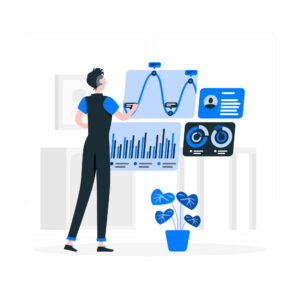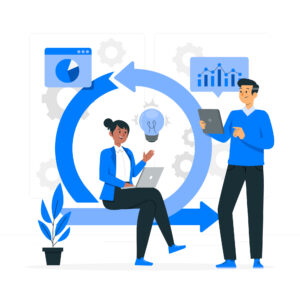The Comprehensive Guide to E-commerce Customer Lifecycle: Unleashing the Power of Data Analysis for Revenue Optimization
- Nikita Agrawal
- March 14, 2024
Table of Contents
Chapter 1: Understanding the E-commerce Customer Lifecycle
In the vast and dynamic world of e-commerce, navigating the customer journey is not only essential but also a strategic imperative for success. Understanding and optimizing this journey is essential for e-commerce businesses to enhance engagement and increase conversions. By comprehending the customer’s needs and wants at each stage, businesses can create a more effective and customer-centric experience, ultimately leading to improved success and loyalty.
This blog series is your strategic compass for navigating the customer journey, with a focus on leveraging data for business growth. Let’s simplify the complexities of e-commerce, explore key customer stages, and harness the power of data to drive success. Join us as we uncover actionable insights in customer acquisition, conversion, retention, and loyalty. It’s not just about understanding the journey – it’s about unlocking its potential for lasting success in e-commerce.
1.1 The E-commerce Landscape
E-commerce – The Digital Commerce Backbone
E-commerce, a convenient alternative to traditional shopping, has evolved into the driving force behind global retail. The rapid advancement of technology continually reshapes this landscape, presenting businesses with both challenges and opportunities. Staying competitive in this dynamic environment requires a keen understanding of emerging technologies and consumer trends.
In the ever-changing world of digital commerce, businesses must be agile to meet consumers’ evolving preferences. From the integration of artificial intelligence to the influence of mobile commerce, the role of e-commerce in shaping global retail is undeniable. Let’s unravel the insights into navigating the challenges and seizing the opportunities that define success in the modern e-commerce landscape.
Market Trends Shaping the Industry
Staying attuned to market trends is not just a practice; it’s a strategic imperative for e-commerce businesses aiming for sustained success. The surge in mobile commerce has redefined how consumers shop, emphasizing the need for responsive and mobile-friendly platforms. The transformative impact of social commerce, where social media platforms become shopping hubs, has altered the traditional retail landscape. Moreover, the integration of augmented reality has introduced immersive and interactive experiences for online shoppers, paving the way for a new era in digital retail.
In the realm of market trends, artificial intelligence (AI) emerges as a pivotal player, revolutionizing the way businesses engage with customers. AI-powered chatbots offer personalized assistance, enhancing customer interactions. Predictive analytics, fueled by AI, empowers businesses to forecast trends and tailor marketing strategies, ensuring a proactive approach in a rapidly changing market. As we delve into the significance of these trends, it becomes clear that embracing innovation is not just an option; it’s the key to navigating the dynamic landscape of e-commerce successfully.
Importance of Customer-Centric Strategies
The shift towards customer-centric strategies is not just a recommendation; it’s a business imperative. Understanding the needs, preferences, and behaviors of the target audience forms the foundation for success in the dynamic landscape of e-commerce. Placing the customer at the forefront of decision-making processes goes beyond transactional interactions; it’s about building relationships through personalized experiences that resonate.
In doing so, e-commerce businesses not only foster customer loyalty but also unlock the potential for sustainable revenue growth. As we navigate through the intricacies of customer-centricity, we can explore how businesses can tailor their approaches to meet and exceed the expectations of the modern, discerning consumer.
1.2 Customer Lifecycle Overview

1. Acquisition
- The Acquisition phase is the initial stage of the customer journey, focusing on attracting potential customers to your e-commerce platform. It involves implementing various marketing strategies such as SEO, social media marketing and paid advertising campaigns to increase brand visibility and reach.
- Effective data analysis is crucial during this phase to identify the most promising channels for reaching the target audience. Analyzing metrics like click-through rates, conversion rates, and customer demographics helps optimize marketing efforts.
2. Conversion
- After attracting potential customers, the journey progresses to the Conversion phase, where the focus shifts towards converting website visitors into paying customers. Businesses analyze user behavior on their website using tools like Google Analytics to track metrics such as page views, bounce rates, and time on site.
- A/B testing is often employed during this phase to optimize website elements and refine strategies to improve the conversion rate and maximize sales.
3. Fulfillment
- Once a customer completes a purchase, the Fulfillment phase begins, involving the process of delivering products or services to the customer in a timely and efficient manner. It encompasses order processing, inventory management, packaging, and shipping logistics.
- Providing excellent customer service during this phase is crucial for ensuring a positive experience and encouraging repeat business.
4. Growth
- The Growth phase focuses on nurturing existing customers and encouraging repeat purchases. It involves strategies such as personalized marketing, loyalty programs, and customer engagement initiatives to foster long-term relationships with customers.
- Data analysis plays a key role in this phase as well, helping businesses identify opportunities for upselling, cross-selling, and expanding their customer base.
5. Returns
- In some cases, customers may initiate Returns, marking a critical point in the customer lifecycle. Handling returns effectively is essential for maintaining customer satisfaction and loyalty. Businesses should streamline the returns process and gather feedback to improve the overall customer experience.

Understanding and optimizing each stage of the e-commerce customer lifecycle is a continuous process. In the subsequent chapters of this guide, we will delve deeper into the role of data analysis in each phase, exploring key metrics, analytics tools, and strategies for revenue optimization. Stay tuned as we unravel the intricate web of e-commerce analytics in the following chapters.
Chapter 2: Data Analysis as the Cornerstone
In the dynamic landscape of e-commerce, where every click, scroll, and purchase leaves a digital footprint, the true narrative of success is inscribed in the language of data. Welcome to Chapter 2, where we delve deep into the beating heart of e-commerce operations — Data Analysis. Here, data is not just numbers; it’s the compass guiding businesses through the intricate paths of the customer journey.
As we unlock the secrets within this data-driven chapter, we’ll illuminate the transformative power of analytics, showcasing how it emerges as the essential guide in steering businesses toward Revenue Optimization.

2.1 Leveraging Analytics in E-commerce
Unleashing the Power of Data
Data is the backbone of business intelligence. Employing analytics in e-commerce means tapping into this valuable resource for actionable insights. Understanding user behavior, tracking key metrics, and making informed decisions based on data are essential for sustainable growth.
In this dynamic landscape, data serves as a compass, guiding businesses to tailor marketing strategies and create personalized experiences. Each data point analyzed refines these strategies, identifying strengths to amplify and areas for improvement. Moreover, data-driven decision-making enables businesses to stay agile, adapting quickly to evolving market trends.
In essence, data is the cornerstone of success in e-commerce. It empowers businesses to anticipate customer needs, enhance operational efficiency, and drive revenue growth. As we delve deeper into analytics, each data point becomes a catalyst for unlocking new possibilities in the ever-evolving world of e-commerce.
Key Metrics for E-commerce Success
- Conversion Rate:
The percentage of website visitors who complete a desired action, such as making a purchase. The average global e-commerce conversion rate was 2.7% to 3% in 2021, and the average e-commerce conversion rate was around 2.5% to 3% in 2023.
- Average Order Value (AOV):
The average amount spent by customers in a single transaction. It is an important metric for understanding customer purchasing behavior and can be increased through upselling and cross-selling strategies.
- Customer Lifetime Value (CLV):
The total revenue a business can expect from a customer throughout their entire relationship. Higher customer lifetime value refers to the valued customers who can bring in more profit to your business. Moreover, a high CLV means a higher return on investment, customer loyalty, time-saving, marketing, increased regular customers, and cross-selling capability.
- Churn Rate:
The churn rate is the percentage of customers a company has lost over a specific period. A high churn rate can lead to a decrease in the conversion rate, indicating the need to work on enticing repeat customers.

2.2 E-commerce Analytics Tools
Within the expansive realm of e-commerce analytics, businesses are presented with a diverse array of tools meticulously designed to address specific operational needs. The efficacy of these tools is contingent upon aligning their functionalities with the nuanced objectives of the business at hand. A judicious selection process is imperative, necessitating a meticulous understanding of each tool’s capabilities.
Google Analytics:
Positioned as a quintessential cornerstone, Google Analytics stands out for its comprehensive suite of web analytics features. Businesses can gain profound insights into website traffic, user behavior, and conversion metrics. Its prowess in presenting data through intuitive dashboards and robust reporting mechanisms is unparalleled, catering to a spectrum of analytical needs.
Out of The Blue
Out of The Blue stands out among e-commerce analytics tools due to its focus on continuous comprehensive monitoring, automatic root cause analyses, and real-time visibility into revenue-impacting events across the buyer journey. OTB does this by reducing revenue loss, leakages and missed revenue capture by monitoring site errors across your tech stack, also improves conversion by highlighting revenue-impacting CX issues and opportunities across the buyer journey. The platform aims to help e-commerce brands drive top-line revenue growth, fix revenue leakage, and reduce costs.
3 . Mixpanel:
Tailored for the discerning requirements of user-centric analytics, Mixpanel distinguishes itself by placing a paramount emphasis on granular insights into user behavior. This tool is particularly adept at tracking events, facilitating a nuanced understanding of user interactions within digital interfaces. Mixpanel’s focus on mobile analytics further fortifies its standing in an increasingly mobile-centric e-commerce landscape.
4 . Hotjar:
Positioned as an invaluable ally in user experience optimization, Hotjar transcends conventional analytics tools by incorporating heatmaps and session recordings. These features unveil a visual narrative of user interactions, offering businesses an unparalleled vantage point to comprehend how users navigate and engage with their digital assets. This tool’s emphasis on qualitative insights complements the quantitative data provided by its counterparts.
Navigating this diverse landscape requires a judicious evaluation of the distinctive features offered by each analytics tool. The decision-making process should be anchored in a meticulous analysis of business objectives, ensuring a harmonious alignment with the selected tool’s capabilities. As the digital terrain continues to evolve, an informed selection of analytics tools becomes an instrumental compass, guiding businesses toward data-driven success in the dynamic realm of e-commerce.

2.3 Customer Segmentation and Personalization
Importance of Segmentation
In the diverse landscape of consumers, recognizing that not all customers are the same is paramount. Customer segmentation, the practice of categorizing the customer base based on shared characteristics, emerges as a strategic necessity. This approach allows businesses to fine-tune marketing strategies, communication, and offers, ensuring they resonate with specific segments.
By embracing segmentation, businesses maximize relevance and impact, forging deeper connections with their audience and driving more effective outcomes. In essence, segmentation isn’t just a tool; it’s a strategic compass guiding businesses toward precision and resonance in their interactions with diverse customer groups.
Tailoring Experiences for Different Customer Segments
Recognizing and responding to the distinct needs and preferences of various customer segments is important for business success. This understanding enables businesses to craft tailored and personalized experiences that resonate with specific audience groups. Whether conveyed through targeted email campaigns, customized product recommendations, or exclusive offers, this level of personalization significantly amplifies customer satisfaction and fosters long-term loyalty. In essence, by customizing experiences for diverse segments, businesses not only meet individual preferences but also create a more meaningful and engaging relationship with their customers.
Personalization Strategies for Maximum Impact
- Dynamic Content:
Adapting website content based on user behavior is a powerful personalization strategy. By dynamically adjusting what users see based on their interactions, businesses create a more engaging and relevant online experience. From homepage banners to product recommendations, dynamic content ensures that every visit is tailored to the individual’s preferences.
2. Recommendation Engines:
Offering personalized product suggestions through recommendation engines is a game-changer in e-commerce. These engines analyze user behavior, purchase history, and preferences to suggest products that align with individual tastes. This not only enhances the shopping experience but also increases the likelihood of successful conversions by presenting customers with items they are more likely to be interested in.
3. Targeted Email Campaigns:
Sending customized messages based on customer preferences and purchase history is a cornerstone of effective email marketing. By leveraging data insights, businesses can create targeted email campaigns that resonate with recipients. Whether it’s showcasing new arrivals, offering personalized discounts, or suggesting complementary products, targeted email campaigns enhance engagement and drive conversions.
Incorporating these personalization strategies not only improves the overall customer experience but also establishes a deeper connection between the brand and its audience. As businesses continue to navigate the digital landscape, these strategies prove essential in creating a more tailored and responsive interaction at every touchpoint.
In the dynamic landscape of e-commerce, the ability to turn raw data into actionable insights is a competitive advantage. In the upcoming chapters, we will explore how businesses can apply these insights to navigate the different phases of the customer lifecycle, optimizing revenue and building lasting relationships with customers. Stay tuned for a deeper dive into analytics strategies and their application in the e-commerce ecosystem.
Chapter 3: Analyzing the E-commerce Customer Journey: Data Insights at Every Stage
Embarking further into the dynamic landscape of e-commerce, Chapter 2 serves as our compass, guiding us through the intricate pathways of the customer journey. Here, the focus sharpens on understanding and seamlessly navigating every phase of the Ecommerce Customer Lifecycle. For businesses aspiring to not just transact but to cultivate enduring and meaningful relationships with their customers, this chapter unravels the blueprint for success.
Let’s dissect each stage, uncovering the strategic nuances that transform mere transactions into a holistic and engaging customer journey. In the heart of e-commerce operations, where every click marks a step in this journey, we unveil the secrets to creating lasting connections and navigating the evolving landscape of customer expectations. Let’s delve deep into the essence of the Ecommerce Customer Lifecycle and unveil the artistry that transforms visitors into loyal advocates.

3.1 Acquisition Phase: Strategic Data-Driven Audience Attraction
The Acquisition Phase marks the initial stage of the customer journey, serving as a pivotal gateway to success in e-commerce. Attracting the right audience is not merely a goal but a strategic imperative, and this phase delves into the intricacies of data-driven strategies that enable businesses to effectively pinpoint and engage potential customers.
1. Strategic Audience Targeting
Strategic audience targeting involves leveraging data analytics to identify and understand the characteristics, preferences, and behaviors of the target audience. By utilizing demographic data, online behavior patterns, and market segmentation, businesses can tailor their marketing efforts to resonate with specific audience segments, thereby maximizing the impact of their acquisition strategies.
2. Channel Diversification and Optimization
The Acquisition Phase emphasizes the importance of diversifying marketing channels and optimizing their performance. This includes leveraging various platforms such as search engines, social media, email marketing, and influencer partnerships to reach a broader audience. Data analysis plays a crucial role in identifying the most effective channels for engaging the target audience and optimizing marketing spend for maximum reach and impact.
3. Content and Messaging Alignment
Crafting compelling and resonant content that aligns with the interests and needs of the target audience is fundamental in the Acquisition Phase. Data-driven insights enable businesses to create personalized and targeted messaging that speaks directly to the pain points, aspirations, and preferences of potential customers, enhancing the effectiveness of their acquisition efforts.
4. Performance Tracking and Optimization
Effective data analysis is essential for tracking the performance of acquisition strategies. Metrics such as click-through rates, conversion rates, and customer demographics provide valuable insights into the effectiveness of various marketing initiatives. By analyzing these metrics, businesses can optimize their marketing efforts in real-time, ensuring maximum reach and engagement with potential customers.
5. Social Media and Paid Advertising Analytics
Mastery of social media and paid advertising analytics is imperative in the Acquisition Phase. The efficacy of paid advertising campaigns directly correlates with performance, demanding meticulous tracking and analysis. Through in-depth analysis of paid campaigns, businesses can gain insights into their impact, facilitating real-time adjustments for maximum results.
The Acquisition Phase is characterized by a data-driven approach to audience attraction, enabling businesses to strategically identify, engage, and convert potential customers. By leveraging data analytics, optimizing marketing channels, and tailoring content to resonate with target audiences, businesses can lay a solid foundation for successful customer acquisition and long-term growth in the e-commerce landscape.
3.2 Conversion Phase: Insightful User Journey Analysis
The Conversion Phase represents a critical stage in the customer journey, where the primary objective is to transform website visitors into paying customers. This phase involves insightful analysis of user behavior on websites, iterative testing, and optimization of various elements to drive successful conversions.
1.User Behavior Analysis
Understanding user behavior on websites is paramount in the Conversion Phase. Utilizing analytics tools such as Google Analytics, businesses gain insights into navigation patterns, page interactions, and potential friction points. By analyzing user behavior, businesses can identify areas for improvement and optimization to streamline the conversion funnel.
2. A/B Testing for Conversion Rate Optimization
A/B testing serves as a cornerstone in the Conversion Phase. This method involves comparing two versions of a webpage to ascertain which performs better in terms of driving conversions. Through A/B testing, businesses systematically evaluate different variations in elements such as headlines, images, or call-to-action buttons, enabling data-driven decisions to optimize the user experience and drive conversions.
3. Iterative Optimization of Website Elements
In the dynamic realm of digital experiences, every element contributes to user engagement. A data-driven approach allows businesses to iteratively optimize website elements such as layout, messaging, and calls to action. By testing different variations and analyzing the results, businesses can refine their strategies to improve the conversion rate and maximize sales.
4. Checkout Process Analytics
The checkout process represents a critical phase in the Conversion Phase. Analyzing the checkout process through data-driven insights allows businesses to identify bottlenecks and potential friction points that may lead to cart abandonment. By gaining a nuanced understanding of user behavior during checkout, businesses can streamline the process to make it more intuitive, efficient, and aligned with customer expectations.
The Conversion Phase revolves around the meticulous analysis of user behavior, iterative testing, and optimization of website elements to drive successful conversions. By employing data-driven insights and A/B testing, businesses can refine their digital experiences, reduce friction in the conversion funnel, and ultimately maximize the number of visitors who convert into paying customers.
3.3 Fulfillment Phase: Efficient Order Processing and Delivery
The Fulfillment Phase marks a crucial stage in the customer journey, focusing on the efficient processing and timely delivery of products or services to customers. This phase is essential for meeting customer expectations, solidifying brand reputation, and fostering repeat business.
1. Efficient Order Processing and Inventory Management
Efficient inventory management lies at the heart of successful fulfillment. Data-driven insights enable businesses to forecast demand, maintain optimal stock levels, and streamline order processing. By leveraging inventory management systems and real-time stock tracking, businesses can ensure prompt order processing, minimize stockouts, and synchronize inventory across multiple sales channels.
2. Warehouse Optimization and Logistics
Warehouse optimization plays a pivotal role in fulfillment efficiency. By implementing data-driven warehouse management systems, businesses can optimize storage layouts, streamline picking and packing processes, and minimize order fulfillment times. Advanced logistics solutions enable businesses to optimize shipping routes, reduce transit times, and provide accurate shipment tracking for enhanced customer visibility and satisfaction.
3. Customer Communication and Support
Effective communication and support are vital components of the fulfillment process. Utilizing automated order confirmation emails and proactive delivery notifications keeps customers informed and reassured throughout the fulfillment journey. Moreover, offering responsive customer support channels enables customers to seek assistance or address any concerns promptly, fostering trust and loyalty.
The Fulfillment Phase encompasses a proactive approach to order processing, inventory management, and logistics, ensuring that customers receive their orders accurately and promptly. By leveraging data-driven insights and optimizing warehouse and logistics operations, businesses can enhance customer satisfaction, minimize fulfillment errors, and set the stage for positive post-purchase experiences.
3.4 Growth Phase: Nurturing and Retaining Customers
The Growth Phase is a pivotal stage in the customer lifecycle, focusing on nurturing existing customers and encouraging repeat purchases. This phase encompasses strategies and initiatives aimed at fostering long-term relationships with customers, ultimately contributing to sustained business growth and success.
1. Data-Driven Customer Nurturing
Data analysis plays a crucial role in the Growth Phase, enabling businesses to identify opportunities for upselling, cross-selling, and expanding their customer base. By leveraging customer data and insights, businesses can personalize their approach, delivering targeted offers and recommendations that resonate with individual customer preferences and behaviors.
2. Personalized Marketing and Loyalty Programs
Implementing personalized marketing initiatives and loyalty programs is instrumental in nurturing customer relationships. Tailoring marketing communications based on customer preferences, purchase history, and engagement patterns enhances relevance and resonance. Loyalty programs, such as reward points, exclusive offers, and personalized incentives, incentivize repeat purchases and reinforce customer loyalty.
3.Customer Engagement Initiatives
Engaging with customers through meaningful initiatives, such as personalized content, interactive experiences, and community building, fosters a sense of belonging and emotional connection. By creating opportunities for customers to interact with the brand and with each other, businesses can deepen customer relationships and cultivate brand advocates who actively promote the brand within their social circles.
4. Feedback and Continuous Improvement
Soliciting feedback from customers and actively listening to their suggestions and concerns is integral to the Growth Phase. By gathering insights into customer satisfaction, preferences, and areas for improvement, businesses can refine their products, services, and overall customer experience. This iterative process of continuous improvement demonstrates a commitment to meeting and exceeding customer expectations, ultimately strengthening customer loyalty and advocacy.
5. Cross-Selling and Upselling Opportunities
Identifying cross-selling and upselling opportunities based on customer behavior and purchase history allows businesses to present relevant and complementary products or services to existing customers. By strategically positioning additional offerings, businesses can increase the lifetime value of customers while providing them with enhanced value and convenience.
6. Retention and Churn Management
Proactively managing customer retention and addressing churn is essential for sustained growth. By analyzing customer retention metrics and implementing targeted retention strategies, businesses can minimize customer attrition and maximize the value derived from their existing customer base.
The Growth Phase represents a proactive approach to nurturing and retaining customers, ultimately driving sustained business growth and success. By leveraging data-driven insights and implementing personalized strategies, businesses can cultivate long-term customer relationships, foster brand loyalty, and create a foundation for sustainable growth and profitability.
3.5 Returns Phase: Streamlining Return Processes for Customer Satisfaction
The Returns Phase represents a critical stage in the customer journey, focusing on managing returns efficiently to resolve customer issues and enhance satisfaction and loyalty. This phase involves strategic approaches aimed at optimizing the returns experience for positive outcomes.
1. Return Policy Transparency and Accessibility
Transparency and accessibility are fundamental in establishing trust and clarity around return policies. Providing clear, concise information about return procedures, including eligibility criteria, timelines, and instructions, ensures customers understand their options upfront. This transparency fosters confidence in the purchasing process and sets expectations for smooth returns if necessary.
2. Automated Returns Initiation and Labelling
Streamlining the returns initiation process simplifies the customer experience and reduces friction. Implementing automated returns initiation platforms allows customers to easily request returns online, eliminating the need for complex manual procedures. Providing printable return labels facilitates hassle-free shipping and ensures accurate tracking of returned items, enhancing efficiency and customer convenience.
3.Data-Driven Returns Analysis and Optimization
Analysing returns data provides valuable insights into product performance, customer preferences, and potential areas for improvement. Leveraging data analytics tools allows businesses to identify trends, patterns, and common reasons for returns, enabling proactive optimization of product quality, descriptions, and sizing charts. This data-driven approach enhances the overall customer experience and reduces the likelihood of future returns.
4. Post-Return Customer Engagement and Feedback
Engaging with customers post-return reinforces brand commitment and loyalty. Following up with customers after returns, through personalized emails or surveys, demonstrates care and attentiveness to their needs. Encouraging feedback on the returns experience provides actionable insights for further refinement of return processes and overall customer satisfaction.
The Returns Phase is integral to customer satisfaction and loyalty, emphasizing the importance of transparent policies, streamlined processes, and proactive engagement with customers post-return. By leveraging data-driven insights and optimizing the returns experience, businesses can instill confidence in their customers, resolve issues effectively, and foster long-term loyalty and satisfaction.
In this chapter, we’ve delved into the practical applications of data analysis at each phase of the customer journey. As we move forward in this guide, we will explore revenue optimization strategies and how businesses can translate data insights into actionable steps for sustainable growth. Join us in Chapter 4 as we uncover the keys to revenue optimization and the importance of leveraging data insights and AI for e-commerce profitability.
Chapter 4: Maximizing Revenue: Leveraging Data Insights and AI for E-commerce Profitability
In the fiercely competitive landscape of e-commerce, businesses constantly seek innovative strategies to enhance revenue streams. One such avenue lies in leveraging data insights and artificial intelligence (AI) to optimize various facets of the e-commerce ecosystem. This chapter delves into the multifaceted approach of utilizing data-driven decision-making and AI applications to maximize revenue across the e-commerce customer lifecycle.

4.1 Conversion Optimization
Conversion optimization stands at the forefront of revenue generation in e-commerce. By harnessing data insights and activating them effectively, businesses can significantly enhance conversion rates and drive revenue growth. Here are some key aspects to consider:
Data Activation Use Cases
Data activation involves harnessing the wealth of customer data available to tailor experiences and offerings. By analyzing browsing behavior, purchase history, and demographic information, e-commerce platforms can personalize recommendations and streamline the purchasing process. This personalized approach not only enhances user experience but also boosts conversion rates, leading to higher revenue generation.
Attribution
Understanding the customer journey and attributing conversions to various touchpoints is crucial for optimizing marketing strategies. Data-driven attribution models enable e-commerce businesses to allocate marketing budgets effectively, focusing resources on channels that drive the highest ROI and revenue.
AI Apps – Revenue Leakage
AI-powered applications like Out of The Blue can help identify and mitigate revenue leakage points within the e-commerce ecosystem. From abandoned carts to checkout friction, AI algorithms can analyze vast datasets to pinpoint areas of improvement and implement proactive measures to maximize revenue retention.
4.2 Personalized Marketing Campaigns
Personalization lies at the heart of effective marketing campaigns in e-commerce. By tailoring messaging and offerings based on customer behavior and preferences, businesses can foster stronger connections and drive higher engagement. Here’s how personalized marketing campaigns contribute to revenue optimization:
Importance of Tailored Campaigns
In the realm of e-commerce, personalized marketing campaigns play a pivotal role in driving customer engagement and revenue growth. Tailoring marketing messages and offerings based on individual customer behavior and preferences enables businesses to establish stronger connections with their audience. This, in turn, leads to higher open rates, click-through rates, and ultimately, conversion rates.
1. Enhanced Customer Engagement
Personalized marketing campaigns resonate more deeply with customers compared to generic messages. By demonstrating an understanding of the customer’s preferences and needs, businesses can foster a sense of connection and relevance, leading to increased customer engagement. This engagement is crucial for nurturing long-term customer relationships and driving repeat purchases.
2. Revenue Growth
Segmenting audiences based on demographics, purchase history, and browsing behavior allows e-commerce platforms to deliver targeted content that aligns with each customer’s interests. This targeted approach enhances the likelihood of conversion, leading to revenue optimization. Furthermore, by providing personalized recommendations and promotions, businesses can effectively upsell and cross-sell to their customer base, further contributing to revenue growth.
Strategies for Implementation
1. Robust Data Infrastructure
Implementing personalized marketing campaigns requires a robust data infrastructure to collect, analyze, and leverage customer data effectively. Businesses need to invest in data management systems and customer relationship management (CRM) platforms to gather and centralize customer information.
2. Advanced Segmentation Capabilities
Advanced segmentation capabilities are essential for dividing the customer base into meaningful segments based on various criteria such as demographics, purchase history, and online behavior. This segmentation allows businesses to tailor their marketing efforts to specific customer groups, ensuring that the content and offerings are relevant and appealing to each segment.
3. Leveraging AI-Powered Marketing Automation Platforms
AI-powered marketing automation platforms are instrumental in automating the process of segmenting audiences and delivering personalized content at scale. These platforms utilize machine learning algorithms to analyze vast amounts of customer data and identify patterns, enabling businesses to create highly targeted and personalized marketing campaigns efficiently.
4. Dynamic Content Blocks and Personalized Product Recommendations
Dynamic content blocks allow businesses to customize the content of their marketing materials based on individual customer attributes or behaviors. This dynamic approach ensures that each customer receives content that is tailored to their specific interests and preferences. Additionally, personalized product recommendations based on past purchases or browsing history can significantly enhance the relevance of marketing communications, driving higher engagement and conversion rates.
5. Behavior-Triggered Emails
Behavior-triggered emails are another effective tactic for personalized marketing. By sending automated emails based on specific customer actions or inactions, businesses can deliver timely and relevant content, such as abandoned cart reminders or product recommendations based on recent browsing behavior. These personalized emails can significantly impact customer engagement and conversion rates.

4.3 Inventory Management
Efficient inventory management is crucial for e-commerce businesses to meet customer demand while minimizing costs and maximizing revenue. By leveraging data analytics and AI algorithms, businesses can optimize inventory levels and avoid stockouts or overstock situations. Here’s a detailed look at how e-commerce businesses can leverage these technologies to streamline their inventory management processes.
Analyzing Demand Patterns
1. Historical Sales Data
- E-commerce businesses can analyze historical sales data to identify demand patterns for different products over time.
- Understanding which products have higher demand during specific periods or seasons allows for better inventory planning and management.
2. Seasonal Trends and Market Dynamics
- By analyzing seasonal trends and market dynamics, e-commerce platforms can gain valuable insights into consumer behavior and preferences.
- This analysis can help in forecasting demand for specific products during different times of the year and adjusting inventory levels accordingly.
3. Predictive Analytics
- Leveraging predictive analytics, e-commerce platforms can forecast future demand with greater accuracy.
- This enables proactive inventory management strategies, such as anticipating demand fluctuations and adjusting inventory levels in advance.
Impact of Avoiding Overstock and Stockouts
1. Overstock Situations
- Overstock situations tie up capital and increase storage costs for e-commerce businesses.
- By optimizing inventory levels based on demand forecasts, businesses can avoid overstock situations and free up capital for other investments.
2. Stockouts
- Stockouts result in lost sales and potential damage to brand reputation for e-commerce businesses.
- Optimizing inventory levels based on demand forecasts helps in minimizing stockouts, ensuring that products are available when customers want to make a purchase.
Tools and Techniques
1. Advanced Inventory Management Software
- Advanced inventory management software equipped with AI capabilities can automate replenishment decisions based on demand forecasts.
- These software solutions can optimize SKU assortment and synchronize inventory across multiple sales channels, ensuring that inventory levels are aligned with demand.
2. RFID Tagging and IoT Sensors
- Technologies such as RFID tagging and IoT sensors offer real-time visibility into inventory levels.
- This real-time visibility facilitates agile decision-making, enables businesses to minimize stock discrepancies, and ensures accurate inventory management.
By leveraging data analytics and AI algorithms, e-commerce businesses can gain valuable insights into demand patterns, optimize inventory levels based on forecasts, and utilize advanced inventory management tools and techniques to streamline their operations. This ultimately allows them to meet customer demand efficiently while minimizing costs and maximizing revenue potential.
4.4 Artificial Intelligence (AI) in E-commerce
Artificial Intelligence (AI) has become a game-changer in e-commerce, offering various capabilities that significantly impact revenue optimization. From predictive analytics to personalized customer interactions, AI-driven solutions are reshaping e-commerce profitability in unprecedented ways.
Predictive Analytics and Machine Learning
1. Forecasting Future Sales
- AI-powered predictive analytics models analyze vast datasets encompassing customer behavior, market trends, and competitor insights.
- This analysis enables e-commerce businesses to forecast future sales with remarkable accuracy, aiding in effective revenue optimization strategies.
2. Optimizing Pricing Strategies
- By leveraging AI-driven predictive analytics, e-commerce businesses can optimize pricing strategies based on demand forecasts and market trends.
- Dynamic pricing models driven by AI algorithms allow businesses to adjust prices in real-time, maximizing revenue potential while remaining competitive.
3. Inventory Management
- AI-driven predictive analytics assists e-commerce businesses in optimizing inventory levels based on demand forecasts.
- This ensures that the right products are available at the right time, minimizing overstock situations and maximizing revenue potential.
4. Marketing Campaigns
- AI-powered predictive analytics can identify customer segments and preferences, allowing for targeted and personalized marketing campaigns.
- This level of personalization enhances customer engagement, leading to increased conversion rates and revenue growth.
Chatbots and Personalized Customer Interactions
1. Enhanced Customer Support
- AI-driven chatbots enhance customer support capabilities by providing instant responses to inquiries and resolving issues.
- This improves overall customer satisfaction and retention, contributing to long-term revenue growth.
2. Personalized Recommendations
- Leveraging natural language processing (NLP) and machine learning algorithms, chatbots deliver personalized product recommendations and offers to customers.
- This personalized approach increases customer engagement, conversion rates, and ultimately drives revenue growth.
3. Guiding Users Through the Purchasing Process
- AI-powered chatbots can guide users through the purchasing process, providing personalized assistance and recommendations.
- This personalized guidance increases the likelihood of successful conversions, directly impacting revenue generation for e-commerce businesses.
In conclusion, Chapter 4 underscores the pivotal role of data insights and AI applications in maximizing revenue across the e-commerce landscape. By harnessing the power of data-driven decision-making, personalized marketing campaigns, efficient inventory management, and AI-driven solutions, e-commerce businesses can unlock new avenues for revenue growth and stay ahead in today’s dynamic market environment.
Also, we’ve explored the future trends that are set to reshape the e-commerce analytics landscape. As technology continues to advance, businesses that embrace these trends will gain a competitive edge by staying ahead of the curve. The journey through the e-commerce customer lifecycle, guided by data analysis and fueled by innovative technologies, is an evolving adventure. As you navigate this landscape, always keep a keen eye on emerging trends and be prepared to adapt your strategies for continued success in the dynamic world of e-commerce. Curious how Out Of The Blue can help?